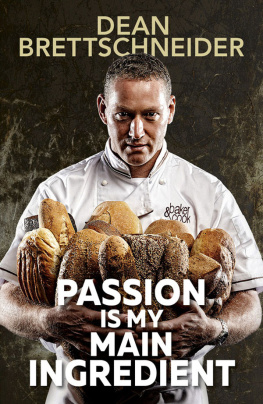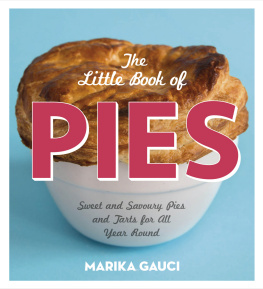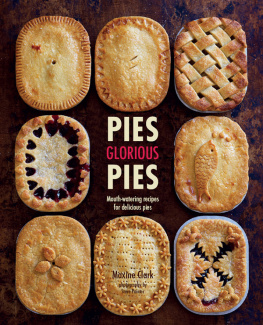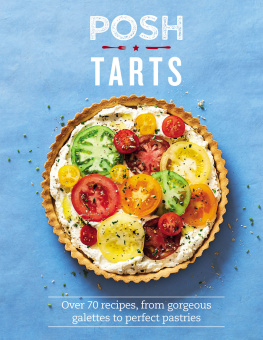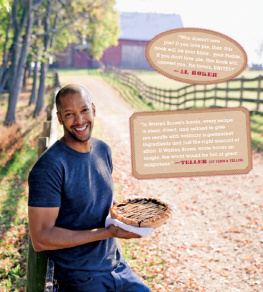Acknowledgements
As with all books there are so many people to thank, but top of my list is Aaron McLean, my trusted photographer and friend. He is a pleasure to work with and knows exactly how I think and reproduces it on film for all to enjoy. Check him out: www.aaronmclean.com
Thank you to Kate Stockman and Catherine OLoughlin at Penguin Group (NZ) for allowing me to write and photograph the book with total confidence. Its always great to work with a talented team of professionals.
A big thank you to Gretchen Lowe, who took up the challenge to help me with this book and spent many, many hours in her kitchen, testing and writing countless recipes for this book. Gretchens taste buds are one of her strong points and when I asked her to come up with some yummy combinations for pie fillings, she immediately sprung into action. Together we fine-tuned the pies into reality. I love working with people who love to learn, and throughout the photography Gretchen was great and there with her apron on! Gretchen, I hope your food dreams come true.
As always, Air New Zealand, Mike Tod and his team are great supporters and partners to everything I do globally and they flew me the many miles it took for me to complete this wonderful book for you to enjoy.
This book would not have been possible without the generous support of Jason Witehira of New World Victoria Park Supermarket, who supplied us with the mountain of ingredients needed. Jason is a true food advocate.
Thanks to Duncan Loney and his team at NZ Bakels for being true Pie Champions by creating and supporting the Bakels NZ Supreme Pie Awards, which has grown to be one of New Zealands most recognised yearly food events, and for supporting all things pie related in this book.
To Tony Brown and the team at Lantmnnen Unibake UK, who have shared my love for creativity in bakery and certainly know great food when they see it. Its truly a great relationship and a wonderful place to work.
Also thanks to the young and talented Vivine Clarke for lending a hand in the books photography and also for flying to Singapore to help out at my artisan bakery and foodstore Baker & Cook.
To Food TV New Zealand, who are great champions of my brand and baking. Thanks in particular to Julie Christie, Greg Heathcote and the exceptional team who work behind the scenes on the shows I am involved with.
To Arno Sturny, Renny Aprea and the AUT School of Patisserie and Baking, who once again came to my rescue by providing us with a great location and support for the enormous photography sessions. You are the unsung heroes of the baking world!
Paul Hansen well, what can I say? Thank you, not only for the wonderful research and words for the History of the Humble Pie, but also for capturing the essence of pie-making when I was only a twinkle in my mums and dads eyes. You are a great friend thank you so much for all your support over my entire career to date.
Happy baking and thank you!
Global Baker Dean Brettschneider
The History of the Humble Pie
The Pie in History
Firstly the question should be asked: what is a pie? The Oxford Dictionary describes it as: A baked food consisting of one or two layers or crusts of pastry with a filling.
Its interesting to note that the first recorded use of the word pie relating to food was as far back as 1303, and by 1362 the pie was well known and popular as a food medium. But when was the first pie reputed to have been made? Lets take a brief journey back in time.
The pie can be traced back in history to the ancient Egyptians. They were prepared and baked by the Pharaohs bakers, who encased fillings in bread dough which was considered a primitive form of pastry dough. These early pies consisted of fillings based on field plants and grains and, if sweetening was required, honey was the key, sought-after ingredient. Even the pie then was considered a delicacy.
Its widely understood that the Greeks were the first makers of pie pastry as such. It was prepared by forming flour and water into a very simple dough, which was in turn wrapped around well-seasoned meats. This pastry encasement served to retain the baking juices within and around the meat fillings. However, this pastry casing was not always intended to be eaten; it served to contain the filling and its varying flavour releases during the baking process.
It is believed that by 100 BC the pie had arrived in Rome. One of the earliest fillings noted by historians was goats cheese and honey. Until this period pies had been fully encased by one outer dough piece, and it is thought that the Romans were the first to make pies with a top and bottom layer around the fillings. However, while both forms of encasement allowed for the preparation of very good fillings, due to the properties of the encased chamber concept, the pastry tended to be discarded rather than eaten.
While not having an exact date to go by, in medieval northern Europe a pastry recipe was later developed using fat in the form of lard and/or butter. This improved the eating and handling properties of the pastry. Lard, in particular, gave the pie dough some resilience and shape retention when not baked in a baking pan or high-sided dish. While there is still some uncertainty around this, it is believed actual pastry recipes became available from the middle of the sixteenth century. Some research, however, finds that the first recipe may not have become available until 1596.
Not surprisingly, therefore, in what was and is a very passionate and creative environment and a proud profession, a number of countries lay claim to the creation of the first pie. On record is a Frenchman, Antonin Carme, who during the period of 17841833, elevated French pastry-making to an iconic art form that endures today. For example, nowadays one of the recipes for puff pastry production is called The French Method.
The meat pie has been part of English cuisine since medieval times. Pie fillings in twelfth-century Britain consisted of beef or mutton; these were followed by game birds and domestic poultry. It is documented that in London in 1850 the first eel and pie shop was opened. The English claim ownership of the introduction of the steak and kidney filling combination, and the Cornish pasty is also a first belonging to Britain. While not a pie by definition, it is a filling encased in a pastry dough of sorts and is baked free-standing as were the very early pies. (Its interesting to note that most early research indicates that pies were baked, not cooked: raw fillings, as opposed to precooked fillings, were positioned within the dough and then sealed to cook within the baked casing.)
Small pies are often referred to as tartlets but, back in medieval times, a tartlet was a shallow but large open pie. Another common term for a pie was a coffin because of the shape of the lidded baking container. Traps were pies with no tops. Ancient Egyptian pies were commonly called galettes. The one relatively common theme drawn from all these names is that over generations of pie-baking the shape of the pie has changed very little.
Many early pies had a national or iconic ingredient present in the recipe. For example, the Irish Pie is commonly referred to as the steak and Guinness pie, in which part of the filling consists of Guinness Stout, bacon and onions. The pumpkin pie, one of Americas iconic pies, was created in 1623. Another American classic is, of course, the apple pie.


